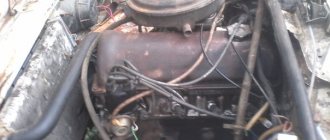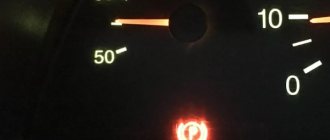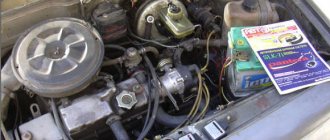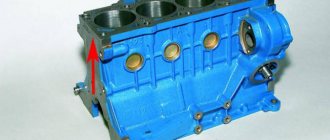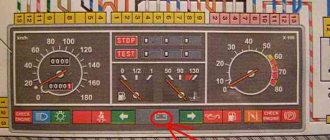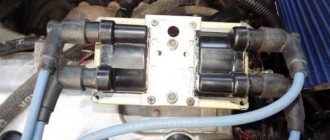Print this article Font size 16
It's no secret that the engine is the main unit of the entire car. Your ability to drive a car, consume the optimal amount of fuel, and more depends on its performance. But overheating is a very common situation in which many people make serious mistakes.
Attempting to cool the engine with water or using other similar “tricks” may not only not help reduce its temperature, but also lead to serious consequences, including the need to completely replace the power unit.
Carburetor engine
Thermostat malfunction
The cooling system of the VAZ line consists of two cooling circles (large and small). After the engine starts, the coolant moves in a smaller circle. After heating the liquid, the thermostat directs its circulation in a large circle. If the thermostat breaks, the coolant continues to move in a smaller circle.
You can check this as follows: start the car so that it is idling, when the engine warms up to operating temperature, place your hand on the lower radiator pipe. After a while it should warm up, otherwise the thermostat is faulty.
Characteristics of the VAZ 2106 engine
Engine VAZ 1.6l. Years of production. (1976, present day) Block material. cast iron. Supply system. carburetor/injector Type. string Number of cylinders. 4 valves per cylinder. 2 Piston stroke. 80 mm Bore 79 mm Compression ratio is 8.5 Engine displacement 2106. 1569 cm3 Engine power 2106. 75 hp. / 5400 rpm Torque. 116 Nm / 3000 rpm Fuel. AI92 Fuel consumption. 10.3 l in the city. | track 7.4 l. | mixed 10l/100 km Oil consumption. 700 g per 1000 km Overall dimensions of the engine 2106 (LxWxH), mm. 565x541x665 Engine weight 2106. 121 kg Engine oil 2106: 5W-30 5W-40 10W-40 15W-40 How much oil is in engine 2106: 3.75 l. When replacing, I fill in about 3.5 liters.
Service life of the VAZ 2106 engine: 1. According to the plant. 125 thousand km 2. In practice. up to 200 thousand km
TUNING Potential. 200 hp No resource loss. 80 HP
An air cushion has formed in the cooling system
As a rule, air locks form after replacing parts of the cooling system. In most cases, an air cushion forms in the car's heater and impedes the circulation of coolant in the system (one of the signs of the formation of an air lock is incorrect operation of the heater).
This problem can be corrected as follows: place the car on a slope so that the front part is at the top, start the engine at idle and wait 15-20 minutes. This should clear the plug.
Lada 2109 Ap-ak › Logbook › The engine will no longer overheat! Let's learn the intricacies of thermoregulation VAZ.
Hi all!
Today we will talk about the most common causes of chisel motor overheating. I will talk about my experience in repairing and operating a car, so there will be no stupid copying of text in this post. Please do not judge strictly, because... I'm not a professional auto mechanic! The main causes of overheating: 1) The most common reason is a non-working coolant fan
.
I think everyone is familiar with the principle of operation of the coolant fan - it forcibly cools the engine. It may not work for several reasons: 1.1 The coolant temperature sensor is not working. 1.2 No power to the coolant sensor 1.3 The coolant fan itself does not work
CHECKING THE TEMPERATURE SENSOR
So, if you see that the cause of engine overheating is the coolant fan not turning on, the first thing you need to do is check whether it is receiving power. Now turn on the ignition! For carburetor
On 2109 models, the coolant sensor is located on the radiator.
There are 2 wires coming to it and in order to check if there is power on them, simply short them. Don't be alarmed, it's the fan that turned on :)! If it does not turn on, then see the following points. On the injector,
the sensor is located next to the thermostat, under the air filter.
It also comes with 2 wires, but here, unlike the carburetor, you don’t need to short-circuit the wires with each other, you just need to pull out the block and the coolant fan will turn on. If after these steps the fan does not turn on, there are two reasons: No power; There is power, but the fan does not work. To finally make sure there is power, you need to ring the contacts with a multimeter or test lamp. If there is no power, then first of all we look at the fuse, and since the +
of the coolant sensor sits on the same fuse with the signal, it’s enough to just press the horn, but even the horn may not work
IT’S THE SAME FUCKING VAZ :):)
Just look at the fuse if it is intact, we follow the diagram and look at all the contacts.
If there is power, then we simply connect the fan directly to the plus
and
minus
of the battery - now it should turn on, didn’t it turn on? This means we need to replace the fan, or try to repair it :)
Temperature sensor
Based on all of the above, we can conclude that most of the engine overheating depends on the correct operation of the machine’s cooling system. True, there are cases when the temperature sensor does not show the correct coolant temperature.
This can be checked using three resistors 600, 160, 100 ohms. This is done like this: we attach one end of the 600 Ohm resistor to the battery ground and the other to the sensor terminal.
When the ignition is turned on, the gauge needle should show about 50 degrees. Then we do the same procedure with resistors 160 and 100 Ohms. At 160 ohms there should be a reading of about 90 degrees, and at 100 about 100. If the readings are as specified, then the wiring and indicator of the sensor are working correctly and the sensor must be replaced.
Consequences
The consequences can be different, from fairly insignificant to such that the engine can be safely sent to a landfill.
The severity of the consequences of engine overheating directly depends on the actions of the driver himself. The sooner he takes action, the cheaper it will be to eliminate the consequences.
- If the engine runs for less than 10 minutes under extreme loads and conditions, nothing bad should happen. Domestic units are reliable enough to withstand this. In the worst case, the piston surfaces will melt slightly.
- If the engine runs in this mode for more than 20 minutes, more serious consequences should be expected. Most often, cracks form in the cylinder head, it becomes bent, the gasket burns out, the seals are damaged, the inter-ring partitions are deformed, and so on.
- If overheating is completely ignored, the consequences will be tantamount to disaster. First, the combustion chamber will fail, the engine will stop responding altogether, and the piston system will melt.
- When the oil overheats, it loses its lubricating properties, and therefore active friction of moving parts begins.
The most dangerous thing is a connecting rod breaking through the cylinder block wall. If this situation happens, your engine is finished. Look for a new one.
Always check that the coolant reservoir is full
By exercising proper control over the condition of the cooling system, and carrying out all technical work on time to maintain its proper operation, the problem of overheating of the VAZ-2114 power unit will never appear, which will extend the life of the power unit.
If the engine of a VAZ 2109 gets hot: what to do?
Situations when the engine on a VAZ 2109 gets very hot happen quite often. There are many reasons for such a dangerous malfunction, since the cooling system on VAZ cars is far from ideal.
1 - blocks with carburetor wires2 - fuel return hose3 - heater hoses4 - vacuum booster hose5 - fuel supply hose6 - clutch cable tip7 - ignition coil wire8 - radiator hoses9 - throttle rod10 - air damper rod11 - emergency oil pressure warning lamp sensor wire
The cooling system of a VAZ car is designed as follows. There are 2 circles in which the coolant (water or antifreeze) moves, small and large. While the engine is not yet fully warmed up, the liquid circulates in a small circle, but at the moment when the liquid temperature reaches 90 ° C, the thermostat is activated and a large circle opens, passing through the radiator. The following problems may occur in the operation of the engine cooling system:
- thermostat failure (breakdown);
- failure of the cooling fan switch sensor;
- airing of the cooling system;
- coolant leak;
- dirt and debris in the radiator;
- loosening of the driving fan belt;
- water pump failure.
Troubleshooting Methods
Checking the functionality of the thermostat is quite easy. It is necessary to heat the engine to 90 ° C and touch the pipe that goes to the radiator. If it does not heat up, then the thermostat has failed. It is better not to repair the thermostat, but to immediately install a new one. To replace it, you need to open the cap of the expansion tank and drain water or antifreeze from the system.
Loosen and slide the clamps, and then remove the pipes. Before installing a new thermostat, you need to clear everything of the old sealant, and then apply a thin layer of new one, let it dry a little, put on and secure the pipes to the thermostat. If a breakdown occurs on the road, then you need to remove the thermostat and open the damper leading to the radiator. This action will cause the cooling system to work in a large circle all the time.
A failure of the cooling fan switch sensor is determined by the fact that the fan is not working and the radiator is all hot. Ideally, the sensor needs to be replaced, but if trouble happens on the road, then you need to short-circuit the two wires coming out of the sensor and the fan will turn on. If this does not happen, then you need to check the serviceability of the fuses.
The resulting air lock in the radiator occurs due to the difference in the density of air and coolant. It is easy to identify such a breakdown. If when the engine overheats, the radiator is not completely hot, then there is air left in the place where it would be cold. It is expelled by pressing on the upper pipe, while the plug should be open.
In case of overheating associated with a leak of antifreeze or water, it is necessary to replace the failed part. The location of the leak is determined by wet marks. If the breakdown occurs on the road and the leak is due to a defect in the pipe, it can be temporarily sealed with insulating tape. When a leak occurs through a damaged radiator or thermostat, you can get to the repair site by constantly adding the leaking fluid. It is strictly forbidden to add cold water if the engine is overheated.
Causes of overheating
All possible causes of overheating of the power unit of a VAZ 2109 car, as well as other cars, can be divided into two categories:
As you know, domestic nines are equipped with injectors and carburetors. Therefore, we will get acquainted with all the likely situations that can lead to overheating of one or another type of engine.
External
Let's start with the external reasons for the increase in engine temperature.
Causes
Features of the situation
Quite often the engine overheats due to a low level of coolant in the expansion tank. It is not always possible to immediately detect a leak in the system. Antifreeze requires a very small hole in order for it to completely drain out of the tank over several tens of kilometers. The most dangerous leak is coolant entering the combustion chamber or oil, which leads to water hammer
If your engine begins to overheat, pay attention to the condition of the thermostat. This unit controls the movement of coolant along a large or small circuit. If the thermostat breaks down, the coolant stops moving in a large or small circle. In the first case, the engine will have difficulty warming up to operating temperature in winter, and in the second, the engine will constantly overheat
Radiator clogged, ineffective cooling
If almost the main component of the cooling system, that is, the radiator, becomes dirty, overheating will not be avoided. If there is dirt on the radiator fins or its “honeycombs,” heat transfer is significantly reduced. Plus, pay attention to the performance of the fan. It may not work due to belt tension, a broken temperature sensor, or a failed fan motor.
Long-term operation in unacceptable conditions
Often the cause of increased engine temperature is the driver himself, who overestimates the capabilities of his car and operates it in conditions that are contraindicated for it. These include prolonged idling, improper slipping, increased speed - all these situations negatively affect the condition of the engine, since the cooling system does not have time to perform its functions.
Engine operation under detonation conditions
If the driver ignores the appearance of detonation in the cylinders, the engine cooling system will not be able to cope with the load. Add to this the hot weather, and then you won’t envy the engine
Exhaust valve burnout
If the exhaust valve fails, the gases heated to an impressive temperature will overheat the engine. The situation can only be corrected by repairing the power unit
Water pump problems
If the water pump fails or stops working properly, coolant will not be able to circulate through the system. Pump failure may be due to tension in the drive belt, defective pump blades, or breakdown of the pump itself.
Most of these faults can be determined by changes in sensor readings. On an injection engine, things are somewhat simpler, since it is equipped with a large number of sensors. Although sometimes it’s even easier to deal with a carburetor.
Internal reasons
There are several reasons that contribute to internal engine overheating.
Causes
Peculiarities
Accumulation of deposits inside the combustion chamber
This is a typical problem for old VAZ 2109 carburetor and injection engines, which have driven more than 200-300 thousand kilometers. Excess oil forms in the combustion chamber. Oil burns poorly, causing plaque to accumulate on the walls. This leads to overheating, which the temperature sensor cannot report. The malfunction can be determined by the bluish smoke protruding from the exhaust pipe. Or the impaired performance of the motor will indicate this
Plaque in the cooling radiator
The mistake of many owners of domestic cars is that they consider it sufficient to pour plain water into the cooling system, replacing the not-so-expensive antifreeze with it. But due to contamination of the water or the use of low-quality coolant, plaque forms on the walls and tubes, preventing normal cooling of the engine. It is not uncommon that the channels are simply blocked by plaque, which leads to impaired access of coolant to them. Overheating is only a matter of time in such a situation
We don’t know how to explain the desire to add all kinds of additives to the oil. But if you do this and don’t know why these additives are actually needed, an impressive coating will form on the cylinder walls, due to which a violation of the efficiency of the cooling system cannot be avoided
It is not enough just to know about the probable causes of overheating of your carburetor or injector on a VAZ 2109. Be sure to familiarize yourself with the consequences, as well as your actions in a given situation.
VAZ 2115 is heating up! How he already got me. | Topic author: Zhanna
Victoria The problem is as old as time. It can be solved with several options, stingy as it is now - I change everything and try everything. The most expensive option. 1. Thermostat - check for complete operation in a saucepan. 2. Radiator temperature sensor, set to a lower temperature. 3. Change the steam-air valve, easier the cover. 4. Replace the engine temperature sensor. 5. Remove air from the system. Everything will have to be done in a complex manner.
The simplest and cheapest is to go for diagnostics, as I understand it, the auto injector, in the settings you are given a lower temperature for starting the fan in the BC, for one thing they will tell you at what temperature the fan starts now.
Liliya drain all the antifreeze and fill it with air in the system according to the instructions, most likely
Margarita antifreeze heating sensor that goes to the fan
The basics - coolant is leaving
There are many problems with heating the VAZ 21099 engine (this is a headache for both carburetor and injection models), this is a low-quality coolant reservoir. Even if it is not operating at its maximum capacity, a breakdown often occurs and all the liquid disappears. There are very frequent cases when the container bursts at the soldering site.
Sometimes the expansion tank valve jams, which maintains high pressure in the system. If it stops releasing too much pressure, the tank may burst or the hoses may break off their fastenings. As a result, the tightness of the entire system is broken and its efficiency drops to zero.
How to fix
Damaged parts are replaced with new ones. But they are also quite cheap. However, sometimes it is necessary to carry out temporary repairs in order to reach the house or workshop.
- firstly, if an increase in temperature is noticed (and it persists), then it is better not to be lazy and stop. Looking under the hood reveals minor problems that can easily be fixed. For example, the amount of liquid in the tank will immediately become clear; drips or torn hoses will be visible;
- to reduce the temperature, turn on the stove at full power;
- Even electrical tape will do for a quick repair. It will be enough to contain the leakage of liquid from burst hoses or a tank.
Tips and tricks
In practice, most drivers, noticing an increase in temperature, strive to turn off the engine as quickly as possible. Please note that if the arrow is in the red zone, then this decision can be considered the only correct one.
However, if there is overheating, but the temperature has not reached a critical level, then it is better not to turn off the engine immediately. It is optimal to immediately reduce the speed, then stop the car and let the unit run for a couple of minutes.
The fact is that this method helps to avoid deformation and cracking of highly heated parts after they have cooled. It is also forbidden to open the expansion tank cap on a hot engine, as this may cause burns. It is also forbidden to add coolant to the tank until the engine has cooled down. The difference in temperature between heated engine parts and the liquid being poured can also cause deformation.
At the same time, it is necessary to check the functionality of the pump at each service, as well as the condition of the drive belt. In some cases, attention should be paid to the temperature sensor, which is responsible for triggering the cooling fan.
An additional recommendation is to wash the radiator and engine compartment. In this case, it is necessary to carry out all work correctly so as not to flood the electrical equipment, damage the radiator, cooling fan, etc. For older cars, it is also advisable to carry out internal cleaning of the cooling system and rinse the radiator from scale and rust.
Let us also add that if in winter the engine and engine compartment were insulated using various insulation materials, then all of these elements must be removed in order to improve cooling and reduce the load on the system.
Any suspicions? Let's check!
While it is easy to check the condition of the radiator or the fluid level in the expansion tank, the average driver will not be able to find out anything about the thermostat, water pump, or the quality of antifreeze. Antifreeze usually lasts 5 years; the pump, depending on the model, is changed every 60,000 - 100,000 km. More exact dates can be found at the nearest FAVORIT MOTORS Group dealership: if you suspect that the engine is overheating, sign up for diagnostics right now. Remember that real overheating is always a big expense, which is actually easy to avoid.
The radiator is not working well
If the radiator is clogged, the car does not overheat immediately, but after about 10-15 minutes from starting the engine. This problem is especially typical for older, carburetor versions of the VAZ 21099.
In this case, the system can be completely sealed, there will be enough liquid in it, but due to completely or partially clogged tubes, heat is transferred poorly.
How to fix
Prevention will help you avoid problems with the radiator. To do this, it is recommended to keep it clean and prevent dirt from sticking. It is enough to simply rinse the radiator mesh well under water pressure.
Experienced technicians also advise not to forget that the tubes in the radiator tend to become clogged, and chemical deposits and scale form there. To get rid of them, you will need to remove the radiator and wash its tubes with water under pressure. Then dry it a little and put it back.
